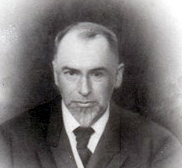The Man That Time Forgot – Edward Page Mitchell and the Burden of Anonymity
 On September 18, 1881 The New York Sun published The Clock That Went Backward. Written anonymously, it is the story of two cousins who, with the aid of a mysterious, derelict clock, travel three hundred years into the past to become major players in a pivotal battle during the Eighty Years War. Three days after the story’s printing, a young man named Herbert George Wells celebrated his fifteenth birthday. It would be another seven years until the earliest drafts of what would become The Time Machine appeared serialized in The Science School Journal.
On September 18, 1881 The New York Sun published The Clock That Went Backward. Written anonymously, it is the story of two cousins who, with the aid of a mysterious, derelict clock, travel three hundred years into the past to become major players in a pivotal battle during the Eighty Years War. Three days after the story’s printing, a young man named Herbert George Wells celebrated his fifteenth birthday. It would be another seven years until the earliest drafts of what would become The Time Machine appeared serialized in The Science School Journal.
To read the introduction to any edition of The Time Machine is to encounter a line praising Wells as the father of modern science fiction, or some variant thereof. Yet simple logic dictates that, due to a lack of attribution and non-existent copyright laws, Wells would have encountered The Clock That Went Backward in some reprinted form or other. If this is the case, Wells seems less the father and more the bastard son.
 It wasn’t until forty years after his death that Edward Page Mitchell was identified as the author of The Clock That Went Backward, along with a multitude other short stories which unveil the work of a visionary who has been shrouded in obscurity for over a century. The question thus arises, Why is such an author not heralded in the canon of modern science fiction? As editor of The New York Sun, it is conceivable that Mitchell opted against attribution for sake of form. Of the thirty stories now known to be his, only The Tachypomp, the story of a device capable of infinite speed, carried his name (although even that was first printed anonymously). Furthermore, the stories appeared exclusively in newspapers, a much more ephemeral medium for fiction than the journal or anthology. Regardless, Mitchell’s work may very well stand as the benchmark for modern science fiction. The following quote, from Sam Moskowitz’s Lost Giant of American Science Fiction, to-date the only scholarly work on Mitchell’s legacy as well as the introduction to his collected stories, makes clear his importance.
It wasn’t until forty years after his death that Edward Page Mitchell was identified as the author of The Clock That Went Backward, along with a multitude other short stories which unveil the work of a visionary who has been shrouded in obscurity for over a century. The question thus arises, Why is such an author not heralded in the canon of modern science fiction? As editor of The New York Sun, it is conceivable that Mitchell opted against attribution for sake of form. Of the thirty stories now known to be his, only The Tachypomp, the story of a device capable of infinite speed, carried his name (although even that was first printed anonymously). Furthermore, the stories appeared exclusively in newspapers, a much more ephemeral medium for fiction than the journal or anthology. Regardless, Mitchell’s work may very well stand as the benchmark for modern science fiction. The following quote, from Sam Moskowitz’s Lost Giant of American Science Fiction, to-date the only scholarly work on Mitchell’s legacy as well as the introduction to his collected stories, makes clear his importance.
He wrote the earliest known story utilizing a theory suitable for faster than light travel, and in 1874.
He wrote a time machine story in 1881, seven years before H.G. Wells…
The first fictional concept of a neo-electronic thinking computer functioning in the head of a human was his in 1879.
…There is no previous story on record of the creation of an invisible man through scientific means than his in 1881, and the scientific explanation and at least one of the incidents are very close to that of H.G. Wells’s [sic] which it preceded by sixteen years.
The first use of freezing by a mechanical process so that a person can be revived at a later date was his in 1879.
And the list goes on. From light-speed to cryonics, Edward Page Mitchell seems more a prophet than an author and if it is indeed true that such ideas originated with him, his elevation into the pantheon of science fiction genius is long overdue.
~
This is the first in a series of articles exploring Edward Page Mitchell’s role in the origins of science fiction. The tale continues in Tracking the Invisible Man, The Manifest Destiny of Hollow Earth and Hard-Boiled Wonderland at the End of the States



